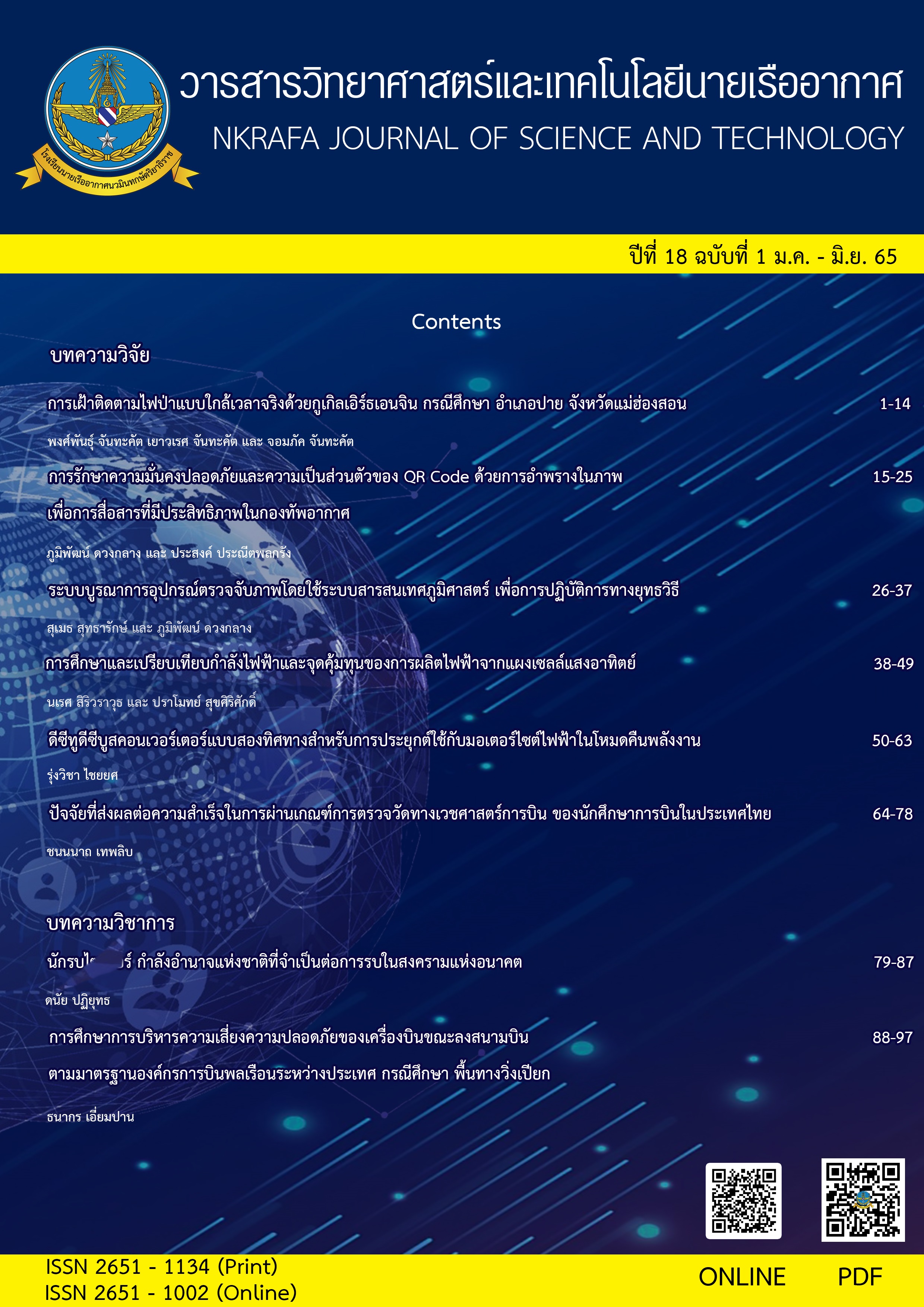Near Real Time Wildfire Monitoring using Google Earth Engine: A Case Study of Amphoe Pai, Mae Hong Son Province
Main Article Content
Abstract
The objective of the study was the guideline of the application of Google Earth Engine (GEE) for monitoring and analysis of wildfire by using satellite imagery of Terra/Aqua in the system of MODIS from database of the Fire Information for Resource Management System (FIRMS) by the National Aeronautics and Space Administration (NASA). The present study focused on the presentation of using GEE platform for the assessment and display the amount and cumulative count of hotspots in near real-time and automatic. In addition, it can determine the area of interesting (AOI) and time series. The results of the study presented the most of hotspot areas. It is useful for monitoring and planning of the protection of wildfire. In this study, the accuracy assessment was done by comparing with the locations of wildfire in year 2020 in Amphoe Pai, Mae Hong Son province as a case study. The study indicated that the values of total accuracy were 76.19% and the Kappa coefficient of correlation were 0.78. It means the results in good level. As a result, the application of GEE platform for monitoring wildfire in near real-time and automatic can be used as an efficient tool for monitoring the risk area of wildfire.
Article Details

This work is licensed under a Creative Commons Attribution-NonCommercial-NoDerivatives 4.0 International License.
- Content and information in articles published in NKRAFA Journal of Science and Technology are comment and responsibility of authors of articles directly. Journal editorial do no need to agree or share any responsibility.
- NKRAFA Journal of Science and Technology Articles holds the copyright of the content, pictures, images etc. which published in it. If any person or agency require to reuse all or some part of articles, the permission must be obtained from the NKRAFA Journal of Science and Technology.
References
DDPM. (2015). National Disaster Risk Management Plan. Department of Disaster Prevention and Mitigation, Ministry of Interior, Thailand. 1-12. Retrieved on July 10, 2021, from https://www.disaster.go.th/upload/download/ file_ attach/584115d64fcee.pdf
Pollution Control Department. (2015). Smog and weather problems. (Type 1). Pollution Control Department.
Flannigan, M. D., Stocks, B. J., & Wotton, B. M. (2000). Climate change and forest fires. The Science of the Total Environment. 262: 221-229.
Nitschke, C. R., & Innes, J. L. (2006). Interactions between fire, climate change and forest biodiversity, CABI Publishing.
Abatzoglou, J. T., & Williams, A. P. (2016). Impact of anthropogenic climate change on wildfire across western US forests, PNAS. 113(42): 11770-11775.
Juntakut, P. (2020). Assessment of Drought Impacts on Urban Green Areas With the Climatic Drought Index in Nakhonratchasima City, Thailand. วารสารวิชาการ โรงเรียนนายร้อยพระจุลจอมเกล้า. 18(1): 15-22.
Simon, P., Eva-Maria, F., & Corinne, F. (2017). A Fully Automatic Instantaneous Fire Hotspot Detection Processor Based on AVHRR Imagery-A Timeline Thematic Processo. Remote Sens. 9(1).
Nion, S., Sarawut, P., & Vivarad, P. (2017). Near Real Time Wildfire Monitoring in Chiang Rai Province using Mobile Phone Application. Information Technology Journal. 13(2).
ดาวุฒิ กาลาเอส และคณะ. (2019). การวิเคราะห์พื้นที่เสียหายจากไฟป่าด้วยข้อมูลจากดาวเทียมในพื้นที่ป่าอนุรักษ์และป่าสงวนแห่งชาติ จังหวัดแม่ฮ่องสอน. วารสารวิจัยและพัฒนาวไลยอลงกรณ์ในพระบรมราชูปถัมภ์. 14(1): 72-81.
Nigro, J., Slayback, D., Policelli, F., & Brakenridge, G. R. (2014). NASA/DFO MODIS Near Real-Time (NRT) Global Flood Mapping Product Evaluation of Flood and Permanent Water Detection. Eval. Greenbelt MD. Retrieved on July 10, 2021, from https://floodmap.modaps.eosdis.nasa.gov/documents/NASAGlobalNRTEvaluationSummary_v4.pdf
Wang, Y., Colby, J. D., & Mulcahy, K. A. (2002). An efficient method for mapping flood extent in a coastal floodplain using Landsat TM and DEM data. Int. J. Remote Sens. 23: 3681–3696.
พงศ์พันธุ์ จันทะคัต และคณะ. (2021). แนวทางการประยุกต์ใช้กูเกิลเอิร์ธเอนจินเพื่อการเฝ้าติดตามและประเมินผลความเสียหายจากภัยธรรมชาติ. The 26th National Convention on Civil Engineering. Golden City Hotel. Rayong. Thailand.
Google Earth Engine. (2020). Retrieved on July 15, 2021, from official website: https://earthengine.google.com
สุภาสพงษ์ รู้ทำนอง. (2562). การสกัดและประเมินพื้นที่ถูกเผาไหม้โดยใช้ค่าความแตกต่างของดัชนีเชิงคลื่นหลายช่วงเวลา จากข้อมูลแลนด์แซท 8 : กรณีศึกษา อุทยานแห่งชาติคลองวังเจ้า คลองลานและแม่วงก์. วารสารมนุษยศาสตร์และสังคมศาสตร์ (สทมส.). 25(2).
พิจิตรา พะยิ้ม. (2562). การเปรียบเทียบการกระจายตัวของจุดความร้อนที่ตรวจวัดได้ระหว่าง MODIS C6 กับ VIIRS
ในพื้นที่อำเภอลานสัก จังหวัดอุทัยธานี. (วิทยานิพนธ์ วิทยาศาสตร์บัณฑิต, มหาวิทยาลัยนเรศวร พิษณุโลก).
สำนักงานจังหวัดแม่ฮ่องสอน. (2564). รายงานบรรยายสรุปจังหวัดแม่ฮ่องสอน ประจำปี 2564. สืบค้น 21 มีนาคม 2564, จาก http://www.maehongson.go.th/th/province-info/provincial-offices/administrative-region/pai.html
กรมอุตุนิยมวิทยา. (2013). เอกสารวิชาการอุตุนิยมวิทยาน่ารู้เพื่อการเกษตรจังหวัดแม่ฮ่องสอน. สืบค้น 21 มีนาคม 2564, จาก www.arcims.tmd.go.th/DailyDATA/Agromettoknow/NN/อุตุนิยมวิทยาน่ารู้เพื่อการเกษตรจังหวัดแม่ฮ่องสอน.pdf
Vadrevu, K., Csiszar, I., Ellicott, E., Giglio, L., Badarinath, K., Vermote, E., & Justice, C. (2013). Hotspot Analysis of Vegetation Fires and Intensity in the Indian Region. IEEE Journal of Selected Topics in Applied Earth Observations and Remote Sensing. 6: 224-238.
Giglio, L. (2010). MODIS Collection 5 Active Fire Product User’s Guide. Science Systems and Applications, Inc. University of Maryland. Department of Geography. Retrieved on July 8, 2021, from https://gis-lab.info/docs/mod14_ users_ guide_2.4.pdf
Giglio, L., Schroeder, W., & Justice, C. O. (2016). The collection 6 MODIS active fire detection algorithm and fire products. Remote Sensing of Environment. 178(2016): 31-41.
ส่วนควบคุมไฟป่า สำนักป้องกัน ปราบปราม และควบคุมไฟป่า. (2021). สืบค้น 8 มิถุนายน 2565, จาก http://forestinfo. forest.go.th/ fWilde_firedetail.aspx?wf=-1&year=-1&eyear=-1&month=-1&emonth=-1&prov=58
นวพล ลินต๋า. (2563). การหาพื้นที่เผาไหม้จากไฟป่าด้วยภาพดาวเทียม Sentinel-2 กรณีศึกษา อำเภอปาย จังหวัดแม่ฮ่องสอน. (วิทยานิพนธ์ระดับปริญญาตรี คณะเกษตรศาสตร์ ทรัพยากรธรรมชาติและสิ่งแวดล้อม มหาวิทยาลัยนเรศวร พิษณุโลก).
Geo-Informatics and Space Technology Development Agency. (2021). GISTDA. Retrieved on June 9, 2021, from http://fire. gistda.or.th/download-v1.html
Landis, J., & Koch, G. (1977). The measurement of observer agreement for categorical data. Biometrics. 33(1): 159-174.


